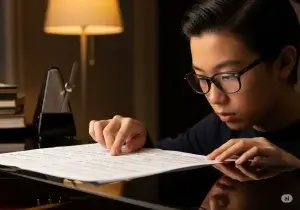Frédéric Chopin is one of the world’s most beloved composers. He composed almost exclusively for the piano, and his pieces contain a dream-like world of rich harmony and emotional beauty. In this article, we’ll cover Chopin’s best pieces, each with an accompanying performance that brings out the best of the music.
What is it about Chopin’s music that is so appealing? Chopin’s aesthetic seems to occupy the perfect intersection between classical and pop – the term “pop” referring to music which is accessible, as Chopin’s undoubtedly is. Chopin follows certain rules of harmonic progression from the Classical era (which demonstrate a simple but satisfying build-up and payoff), and combines it with his own harmonic language (lush, expressive, Romantic, and also drawing upon musical idioms from his Polish heritage).
Chopin, despite living only until the age of 39, left behind a sizable body of work. It can be somewhat daunting figuring out where to start. And what were Chopin’s best pieces? In truth, it’s something of an arbitrary exercise to determine Chopin’s five best pieces – he produced many works that could make this list, and anyone you ask will have a different selection. So let this list be a reminder that taste is subjective (these are my top 5, which change depending on the day and my mood) and a reminder of what a great composer Chopin was. I hope you find some of your favourites in this list. If you’re unfamiliar with Chopin, I hope you discover some new pieces that you love.
So without further ado…
5. Etude in C Major, Op. 10, No. 1
Performed by Vladimir Ashkenazy
(This video won’t embed on a website, so click on the image to view it. It’s worth it, I promise!)
What’s wonderful about this piece is that, although it’s classified as a study (“etude”) (albeit an etude meant for the concert stage), it hits you right in the heart with its chord changes, particularly in the piece’s middle section (0:57 to 1:41 in the video above). The piece itself is a marvel in technical proficiency. An appealing attribute about many of Chopin’s Etudes is that they explore primarily one technical pattern (in this case, widely arpeggiated chords spanning across the keyboard) and hence tend to stay in a single emotional realm. This might make them seem static, but they are anything but; the limitations of this approach allow for an exquisite exercise in tone-painting – it’s little wonder why this etude is nicknamed the Waterfall (not Chopin’s attribute).
This performance by Vladimir Ashkenazy emphasizes both the strength and the emotion of the music. What I love most is how Ashkenazy plays it like a rock star (look at how he pounds out those left-hand octaves); it’s totally befitting of a piece containing such colourful expressiveness.
4. Nocturne in C Minor, Op. 48, No. 1
Performed by Seong-Jin Cho
Chopin’s nocturnes are among his most beloved pieces. As their name suggests, they are pieces which are evocative of the night. They can be alternatingly peaceful, dream-like, mysterious, mournful, and unsettling. Some of them also enter tempestuous states, as this nocturne does.
This breathtaking nocturne is almost like a ballade in terms of its narrative scope and emotional range. It begins with a crystal-clear, beautifully mournful melody. The first section culminates in a moment of catharsis (1:35), ending with a sense of finality. Yet we veer into a peaceful, plagal section (1:54), which gradually gets overtaken by agitated double octaves (3:11). A dam of emotion finally bursts as the octaves cascade down (3:43) and return to the main theme, albeit now decorated with a restless undercurrent in both hands (4:00). What’s most amazing is that the melody of the main theme is faithfully recreated in this agitato section almost entirely note-for-note. It really makes you feel like you’re experiencing a story retold with a new layer of grief, or rage, or both.
But my favourite part is when we reach the cadence: from the memory of the first section, we expect the “home chord,” that sense of finality, but we are completely deceived by a dissonant chord instead (5:02 to 5:15). It’s the musical equivalent of everything falling away – at which point the music really does fall away, leaving us with a lonely rising melody and some soft, concluding chords: desolate, plaintive cries echoing in the distance.
Seong-Jin Cho plays this nocturne with the sensitivity it deserves. The reprise of the main theme (4:00) is one that can be played in many different ways – forceful or mournful, sad or angry – and all have their artistic merit. Cho opts for the mournful route, and it gives his interpretation such colour; his voicing is clear, and the emotional acuity is exquisite.
3. Scherzo in B-flat Minor, Op. 31
Performed by Martha Argerich
Scherzo is the Italian word for “joke.” A piece with this title would suggest a fast, humorous piece of music. However, in Chopin’s hands, the form becomes much more complex. This scherzo moves through a variety of emotional states, comprised as it is of fieriness, humour, and melancholy. Even the jocularity in the first section has a sense of emotional heft to it; it simultaneously sounds both flippant and passionate.
The middle section begins with a musical idea that is both sweet and lonely (3:14), and gets increasingly agitated before a sunburst of joy emerges (4:41). After a repeat of this section, we cascade into musical material that is suspended in tension, and at times even tragic (7:14). We return to the main theme, and the coda (ending section) is like a balloon popping with its effusive sprint to the conclusion.
Martha Argerich’s performances are always, for lack of a better word, fun. Her interpretations are bold, steely, and fearless. She manages to make the music sound spontaneous, while playing with a clear sense of direction and considered musicality. This scherzo is perfect for her style of playing: the piece’s emotional breadth, contrasting sections, large structural scope, and technical challenges all comprise the perfect canvas for Argerich to colour with her engaging, ardent musical touch.
2. Ballade in F Minor, Op. 52
Performed by Krystian Zimerman
A ballade is a piece whose characteristics are quite flexible, but it is generally defined by a dramatic, narrative quality. This is certainly the case with Chopin’s fourth Ballade; over the course of its twelve minutes, one feels like they’re being taken on an epic, emotional journey.
The main theme occurs three times, adorned in different ways, and each with a different mood: the first instance is stark, tentative and mysterious (0:37); the second is grand, urgent, and tragic (3:25); and the third (my favourite) is delirious, sensual, and uncanny (8:04). This last occurrence is followed by a truly transcendent section of music (8:46). (Listen to those two bars of heavenly beauty from 9:03 to 9:09.) Overall, the piece is riveting; even the transitional material is engrossing. And once the ballade ends, it doesn’t even feel as if twelve minutes have passed.
Krystian Zimerman’s interpretations of Chopin’s Ballades are considered among the very best. He is able to connect the piece’s many sections into a coherent narrative. He constantly keeps a propulsive momentum, while remaining faithful to the emotional content, approaching the material with a deft acuity of expression. It’s an extraordinary recording that transports you wholly into the ballade’s emotional world.
1. Andante Spianato and Grand Polonaise Brillante in E-flat Major, Op. 22
Performed by Kyohei Sorita
The Andante Spianato and Grande Polonaise Brillante truly lives up to its majestic name. It is in fact two pieces in one: the Andante Spianato is a gentle, introverted piece, probably closest in form and mood to a nocturne. The main theme, while gentle in temperament, has a constant, cyclical motion, like ocean waves; this is in contrast to the stark middle section, which is heartrending in its stillness and simplicity (3:12).
Once the Andante ends, a fanfare-like passage introduces the polonaise (5:09). The polonaise as a form is based on the Polish dance of the same name, and is characterized as a march. Chopin’s transformation of the dance form into a classical piano piece is quite malleable, but common characteristics of his polonaises are a 3/4 time signature and a fanfare-like rhythm which runs through the left hand.
The Grande Polonaise Brillante is a playful, raucous, and showy piece. Its energy (gleefully) just doesn’t relent. There’s the lovely main theme (5:33), the filigree fioraturas (embellishments) cropping up regularly (6:18, 6:55, 8:12, and many more), cascading runs (8:28), and sections of lyrical gravity (8:47).
My favourite part is the effusive transition (starting at 9:27), like a dam of emotion about to break, leaving us holding our breath on the trill and fioratura (9:41) before it moves into a sentimental, beautiful section featuring an ascending melody suffused with sweetness (9:51).
But once that moment of tenderness is over, another transitional section (this time of dissonant precariousness) rolls in, and finally we are back to the main theme. The main theme is repeated in its entirety, then swiftly swerves into a lengthy coda, with the right-hand melody in wild, constant motion (12:57). The last thirty seconds of the piece features an amusing ascending figure in both hands (twice!) (14:05, 14:11), followed by a celebratory cascade of notes (14:18), bringing us to a truly triumphant conclusion. Yes, I’m gushing. Look, I love this piece. It always brings a smile to my face.
Kyohei Sorita is such an imaginative pianist. His expressive choices are so inspired and elegant, and he’s unafraid to go to musically sentimental places; I feel like he extracts the romanticism from the polonaise more so than other pianists. And of course, he understands the humour, too – this is Chopin at his most playful. An exquisite performance, very much worth watching.
Conclusion: Chopin Is the Best
So there you have it. Five pieces (and performances) of Chopin that highlight not only the composer’s musical prowess, but the moving power of music. And the creativity and commitment required by each pianist featured here to divine a touching, transporting interpretation of this music cannot be discounted.
If you’ve always wanted to learn a piece (or pieces) by Chopin, I offer piano lessons in Mississauga to beginner, intermediate, and advanced levels. You, too, can learn to play Chopin! I look forward to hearing from you!




